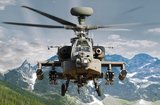Podcast: Revolutions in Vertical Flight S2 E6 - The Role of Autonomy
Welcome to Shephard Studio’s podcast series on Revolutions in Vertical Flight, sponsored by our partner Bell.
Listen on Apple Podcasts, Google Podcasts, Spotify and more.
In our first series, we learnt about the history of vertical flight and discovered the key pioneers and revolutionary moments that created the rotorcraft industry we know today.
In this second series, we learn more about the helicopter’s role in society, and how it helps overcome obstacles, protect the public and ultimately save lives.
We'll hear from a range of operators about how they use helicopters to carry out those tasks that are too expensive or dangerous to conduct by other means. We consider the future, discovering how greater autonomy is poised to reshape the role of rotorcraft even further.
In this episode, we hear how huge investments have been made in electric vertical takeoff and landing, or EVTOL platforms, which could one day transport goods and passengers within cities and beyond.
But what does this mean for the future of the industry?
A transcript of this episode is below:
Jia Xu 00:06 We very much believe autonomy is important and we're taking a no magic step by step approach to get there.
Jay Merkle 00:12 It's about finding those places where human error is making the safety system very fragile.
Linda Flores 00:20 We need people to feel safe. We're going to focus on how to create the safest vehicle possible by focusing on autonomy really is the key there and I think that's a huge step.
Narrator 00:30 Autonomy seems certain to be a defining trend in the future of aviation. Fully autonomous aircraft could one day supplement or even replace traditional helicopters. This evolution is taking place on a number of levels. A range of companies from specialist providers to established industry giants are pursuing systems in urban Air Mobility. In particular, huge investments have been made in electric vertical takeoff and landing, or EVTOL platforms, which could one day transport goods and passengers within cities and beyond.
Narrator 01:21 Welcome to Shepherd Studio's revolutions in vertical flight, brought to you in partnership with Bell. In our first series, we learned about the history of vertical flight and discovered the key pioneers and revolutionary moments that created the rotorcraft industry we know today. In the second series, we learn more about the helicopters role in society, and how it helps overcome obstacles, protect the public, and ultimately save lives. We'll hear from a range of operators about how they use helicopters to carry out those tasks that are too expensive or dangerous to conduct by other means. We consider the future, discovering how greater autonomy is poised to reshape the role of rotorcraft even further.
Michael Thacker 02:16 Obviously, there continues to be a trend towards urbanisation where people are moving into population centres. If you think about the North Texas area, I think they're about 100,000 people a year moving into the Dallas Fort Worth area at this point. That's a large population coming into a large population centre already. What it means is, increased traffic, it means slower access to services, whether those be emergency services, or whether those are just the standard services that you're trying to find to make your life function.
Narrator 02:45 This is Michael Thacker, Executive Vice President of technology and innovation at Bell.
Michael Thacker 02:53 As that interruption comes into your life, we're looking for solutions to make cities more livable, because people find the economics of the city to where they can get jobs and have mobility in their careers. We need to balance that with the ability to live with your family and be able to get the goods and services that you need in a way that's both efficient, but also doesn't destroy the environment.
Narrator 03:15 This could bring cities all sorts of advantages, from the transport of cargo and people, to the speedy delivery of medical supplies, and equipment. All of this will be achieved with less noise and emissions than current aircraft.
Michael Thacker 03:32 There are a couple different aspects to it. First is the idea of emissions and the other is the idea of noise. With regard to emissions, obviously the smaller aircraft can be fully electric, which means they're not emitting as they go, obviously, the energy has to be generated. But as they're flying through the cities, they're not contributing to the kind of brown cloud that's over a lot of cities so that can help environmentally there. From a noise perspective, going to distributed propulsion allows you to reduce the number one driver for rotorcraft noise, which is the tip speed. The larger the rotor, the higher the rotation speed, the more you can lift, but at the same time, the louder it's going to be.
As you distribute that to multiple rotors, that noise, both the size of the rotor, the speed of the rotor comes down, and you get an order of magnitude reduction and the noise that's created by the vehicle, allowing it to blend into the background noise of most cities. If you go back to longer range vehicles and thinking about something it's more, maybe intracity between, Fort Worth and Dallas or maybe between Fort Worth and Austin, you probably need to have a hybrid solution. But still, you're replacing a lot of the burned energy with electric rather than with hydrocarbons. So you get a 30 to 50% reduction in the fuel use for a given trip. Again, you're still doing a favour to the environment and having a more environmentally friendly solution for your transportation.
Narrator 04:53 But what does this mean in reality? While we're unlikely to see a Jetsons style future become reality anytime soon, it's clear that change is coming. Many of those changes are starting to emerge today. Bell is a major player in this developing market, through systems like the Nexus air taxi, and its new cargo drone, the autonomous pod transport 70, or apt 70. Let's hear from Jason Hurst, Vice President of innovation at Bell, and Linda Flores, programme manager for the company's Nexus project.
Jia Xu 05:32 The flying car concept has been out, I don't think we've perfected the suitcase folding yet. Getting the vehicles to the right, weight size certification is a big enough challenge in itself. What I see for my kids first off is, even today, I probably bought my last gas vehicle. There's going to be a large amount of sustainable vehicles out there. I think the multiple modes of transportation will be more important. You're going to see, autonomous buses, handing people off to autonomous taxis. Those have been out there as well. At some point, people are going to adopt to riding backwards, that they're not a big fan of today, and then handing those people off in certain cases, to the autonomous air vehicles as well.
I think we all have that personal bias of we feel a lot better if we have hands on the controls. We have a lot of data, at least from the military side that shows a lot of the accidents are human error. We've got to get enough data, similar to what the automotive industry has done with the autonomous cars that show that it's a highly reliable system, and that there's going to be capabilities that the autonomous aircraft bring that the human eye, can't do. We already rely on those sensors heavily to fly with autopilot and fly in degraded visual environments, and so once we get to the economic cost point of some of those systems, and we show that they can fly 1000s or hundreds of 1000s of hours, accident free, just like the miles that have been logged with autonomous vehicles, then that that will build the trust in those.
Linda Flores 07:09 I think it's funny the way that our engineering team looks at the Jetson analogy, because one of the things that you'll always hear them do, or that you'll always see happen is they will cringe when people say we're making a flying car. It's simply from a precise standpoint that this thing will not actually drive on the ground and then fly. This is going to be an air only vehicle. The distinction there from an engineer standpoint, is very important to the engineering community. However, I think that we are looking forward to a place where you will see air taxis, air vehicles, flying around and providing a solution to commuters that they don't have today. We hope to have many vehicles in the air, that begin to reduce the congestion that we're seeing on roads today.
Something that people can trust when they step onto the air vehicle, we need community acceptance to be much greater than it is today. We need people to feel safe. We're going to focus on how to create the safest vehicle possible by focusing on autonomy really is the is the key there. I think that's a huge step in our progress moving forward. You're going to see us working on autonomy, you're going to see us working on electric propulsion. Those are going to be two key elements that we're not going to take our eyes off. Then we're going to have some other complimentary technologies that we'll be focusing on to get a vehicle that's viable in the market.
Narrator 08:31 The future development of autonomy is far from clear, fully autonomous systems will need not just technological development, but also the backing from authorities and perhaps even more importantly, public acceptance. That being said, autonomy is already making its presence felt across the industry, in avionics systems and beyond. Here's Jay Merkle, Executive Director for the US Federal Aviation administration's UAS office. Speaking during the Farnborough International Air Show virtual event.
Jay Merkle 09:04 It's about finding those places where human error is making the safety system very fragile. We've seen it over and over again. While at the same time, the progression towards autonomy must also recognise that the plasticity and the ability of humans to deal with off nominal cases is very valuable in flight. We definitely see this progression and we have projects in type certification right now that are pilot optional, safety pilot and working towards fully autonomous. So whether highly automated or fully autonomous, we're working through that progression and finding what are the safety parameters that must be addressed as we move to more and more autonomous operations.
And you're right it also has to do with autonomy in the airspace, particularly for air traffic controllers. Knowing the predictable behaviour of these aircraft in off normal conditions. That is so vital for the safety of the airspace. We take it for granted how ingrained it is in legacy aviation. But we have to develop those same patterns for our highly automated autonomous aviation.
Narrator 10:29 Industry is examining the potential of automation from a number of angles. Here's Jia Xu, Senior Director of strategy planning for Honeywell UAM UAS business unit.
Jia Xu 10:42 At Honeywell, we have a vision that the future of air cargo will be completely autonomous from warehouse to your house. Urban original air travel will be ubiquitous and accessible with electrified and highly autonomous aircraft. That's why we're building integrated propulsion and avionics systems for UAM and UAS to make that future a reality. We believe this future very much needs autonomy. We need to eliminate the preventable operator errors and improve aviation safety, we have to prove the unit economics of UAM because now we're carrying fewer people with the same pilot. We have to enable new services like drone parcel delivery, or fulfilment centre connectors, where we can't physically fit the pilot on the aircraft.
Finally, let's not forget, it's not just about the airplane, we also need to introduce autonomy into the Airspace System to enable high volume operations. To those points, Honeywell has been working on this and we have a number of proof points, or a compact fly by wire system is now in the vertical aerospace UAM platform. Our citizen detect radar solution is now been demonstrated on helicopter and UAVs. We have supplies that's radar to UAM companies. We have also just recently demonstrated autonomous landing using helicopters, as well as the leading UAM platform. We very much believe autonomy is important, and we're taking a no magic step by step approach to get there.
Narrator 12:12 Autonomy is already seen to varying degrees in helicopters today. Many of the same trends are seen in modern avionics, which are capable of supporting pilots to a far greater degree than ever before, even conducting a number of tasks on their behalf. Here's Stuart Farquar, operations manager at GCH Aviation, a New Zealand provider of helicopter services.
Stuart Farquar 12:31 Comparing it to the old style should be a lot clearer to the pilot to see what they're trying to do. On top of that, the helicopter is clever enough to do most things that it's told to do as well. Provided you put the right information in, the helicopter can pretty much go where it needs to go on its own virtually. Like I say, on top of that, we're going to do a search or whatever, we can actually put search patterns on to it. This programme is such better than an automatic fire search pattern.
Narrator 13:00 By offloading some of the more basic tasks to the autopilot, the human operators can concentrate on the unique challenging aspects of a particular mission.
Stuart Farquar 13:10 Short search patterns are quite a good example of that, then. There's different styles of search patterns. There's a few search patterns that are greater for wider search for [inaudible 13:22] These are pre-programmed into the helicopters, so you just put a few parameters around it, and then put the search pattern in that area. The helicopter will automatically fly that search pattern at such and such a height and such and such a speed and it will give instead of the pilot, looking inside the fires, the helicopter can start to look outside a bit more and look for what's in the water along with his crew.
Narrator 13:43 Such advances have had a crucial impact in boosting the safety of helicopters. They point to a future where onboard technology supports pilots and crew, not just to accomplish their missions, but to do so in the most efficient and safe ways. Here's Mike Suldo, Bell's, Customer Support Manager for energy.
Mike Suldo 14:04 It's not just the equipment, it's the philosophy, the safety management systems. We're looking for the safest possible thing we can do to safeguard our passengers and our crews. We have hums on the 407 we're developing now. We're putting it on the 407 for health usage monitoring. It will actually tell you what bearing is failing and how long it's got to go. In other words, the outer race the bearing in the tail rotor drive shaft on the third hanger bearing is the outer race is going to fail in 120 hours.
I mean, that's incredible to have that kind of capability to be able to know what's going on in your helicopter. That is really a big step forward in safety It really helps if you can correct the pilot when he's making a mistake, not necessarily fire him or get rid of him, but just say, hey, we don't really fly like that. We need to talk about the way you're making those approaches real nose higher or something. The big proactive and the safety really helps.
Narrator 15:31 Urban Air Mobility is a rapidly growing area of industry focus, with many manufacturers looking to a future of fully autonomous systems, delivering cargo in cities, or even carrying passengers. The FAA recently released a new concept of operations for UAS air traffic management.
Jay Merkle 15:52 Well, the new concept around UAS traffic management was born out of the recognition that when small UAS got to a density in the airspace, there was absolutely no way that we could hire enough controllers or field enough equipment to manage them. We needed a completely new approach. We from the beginning went with a very automated approach. We do expect that as the density of these operations increase, and we see these technologies mature, under UTM, we will see technologies or procedures or operations that may translate well in probably initially in the Urban Air Mobility or Advanced Air Mobility area, and probably maybe eventually make it to places like human transportation. But I think for some time, we'll see these two parallel paths where the Urban Air Mobility will be increasing in its autonomy moving from piloted to safety pilots, to more simplified cockpits, and just progressing on. At the same time, the small UAS traffic density is going to grow. I think at some point in the future, you're going to see those two come together, where that's where the meshing point is going to be.
Narrator 17:25 For Bell, the apt 70 is a key focus, with the company emphasising the platform's versatility. This is Brian Duncan Bell's, business development and strategy director.
Brian Duncan 17:38 The good thing about APT is that it really can go both commercial and military. The applications are really endless. The more and more we talk to customers, the more we understand what the requirements are, we're seeing that we already knew a lot of these missions, that we thought this was perfect for. But the more and more we talked to customers, the more applications we actually uncover. Some of them that we're working right now are the oil and gas sector. APT is perfect, because it can take whether it's a tool, whether it's a spare part, and taking it very fast to a very deserted area, like the Permian Basin, for example, or in certain places in Australia, and other parts of the world, where currently people are, using 18 wheelers to take things.
Narrator 18:30 APT 70 is so named, because it's designed to haul up to 70 pounds of cargo. This capacity could have a huge range of uses in both the commercial and military domains. Here's Kerry Cannon, Chief Engineer for Bell Innovation.
Kerry Cannon 18:47 Yeah, so I see the application app is sort of twofold. You know, one is the commercial variant. I think, only your imagination can limit that as to what it's going to pick up drop off, within the limitations of the aircraft APT 70, getting 70 pounds. A lot fits in 70 pounds, then you've got the military side, which I think, it could be a real game changer for the fact of even at the APT 70 level, that's five gallons of water, that's, ammunition, that's batteries, that's medical supplies, that's radio equipment, spare parts. I think, as that aircraft matures, that's going to be a real key for us, because I think when you sit back and look at all of the missions that are out calling the close support logistics. If you're somewhere around 70 pounds, you're going to hit a very high percentage of those. Because it's not like you need to deliver a truck out there. It's really going to be the basic supplies that it's going to be and then if you can do that without putting other people in harm's way, I think that's going to be a big move for that.
Narrator 20:01 The advantage of designs like the APT 70 is the ability to take off like a helicopter before transitioning into forward flight and offloading much of the lift onto the wing.
Brian Duncan 20:12 The beauty of it is, by the aerodynamics of it, it's actually taking into consideration the pod. The pod helps it fly. But the good thing about APT is that we don't want you to get fixed on the pod. This is our design. But if a client really has a unique need, like in the case of Yamato, in Japan, the largest third party logistics in Japan, they liked the pod, but they wanted to move it around and make it easier, to take it into the logistics chain. That's where we helped. We worked with Yamato and we were able to do a different type of pod design that work better for our customers and partners' unique logistics chain. Here in this pod, you can carry 70 pounds, up to 70 pounds of payload.
These are for electric motors, which is a very green product. The more and more we talk to our customers, the more they crave the product, because in oil and gas, and mining environments, they're not always known for being green. But they're having a directive at the highest level of these companies to go look at disruptive technologies, such as APT that are green, that are electric, that makes their logistics chain much faster and efficient.
Narrator 21:37 Steve Nordlund is vice president and general manager of Boeing Next, which is focusing on building the ecosystem that will support this Urban Air Mobility future. At the Farnborough International Air Show virtual event in 2020, outlined the company's work in this area, including in air taxis.
Steve Nordlund 21:58 We often talk about this ecosystem. What do I mean by the ecosystem? Well, if you go back in time, because I am a believer that history often repeats itself. You go back to the introduction of commercial aviation, the jet age with the 707 back, I think was October 26 of 1958, when it did its first commercial flight. Over time, an ecosystem was developed around that mode of transportation, whether it was the airport, whether it was the runway improvements, whether it was the jetways, that were built, the concessions that went into the airports, the rental cars that have come on site, or the hotels nearby, an ecosystem was developed around the transportation of the jet age.
We believe that history will repeat itself. It's not just about the platform and these new technologies, and how do we safely and economically go and create this new form of flight. But it's also about thinking about the entire ecosystem and how we solve some very difficult problems to go and enable this next chapter of aviation. At Boeing, we're doing quite a bit. We are certainly focused on part of our core talents around the platform development. We're very excited about some of the work that we've done around air taxis. Some of the work that we've done around smaller vehicles, some of the vehicles that we've had in our portfolio for quite some time that we're putting through a flight certification process to help understand what is the safest way to go and certify these platforms in a way that comes to the standard of air travel and air safety that we have all expected.
We have done this in a pretty non-traditional approach by doing some clever joint ventures with other partners in the industry. We've partnered with a company out of Silicon Valley called Kitty Hawk to develop a joint venture called whisk, where we've taken one of the most mature air taxi platforms in the world today and continuing to advance it and also bring the Boeing disciplines and our ability to build aircraft certify aircraft behind those type of products. We've established a joint venture with an artificial intelligence company called spark cognition where we bring this new age of software development, along with this long history of aviation and aerospace know how, combining to how do we set up the right operating system for the air to safely integrate autonomous vehicles into our airspace at scale that can coexist with manned aircraft in a safe environment.
We're looking at high speed travel in our investment in companies like areas that are trying to redefine how supersonic travel happens. Because again, time is our most precious asset. If we can safely economically and environmentally safe move people around the globe faster, society will continue to benefit from that. All in all, we've got a lot of opportunity for us ahead of us. Boeing continues to make strong investments in this area to help fill out some of these areas of the ecosystem that we truly believe in.
Narrator 25:26 There seems little doubt that autonomy will have a huge impact on the helicopter domain. In fact, it's already happening today to varying degrees. However, significant questions remain over just how autonomous technologies will develop in future decades, and the public appetite for their use. Matt Jayne is marketing manager for the Bell 505.
Matt Jayne 25:51 I don't think it's that far away at all. I mean, I think it'll be part of this whole air taxi movement. You look at the military is already doing it with the one that Garmin puts together is a 407 chassis, just with a bunch of computers on board instead of a person in a four axis autopilot. The military always kind of leads the way on these types of things. I mean, even tying it all the way back, you look at the hems operation started with, 47s and a couple of structures on the skids with mash units. I think you kind of see the military already starting to do it and you start to see, they're putting the technology on Blackhawk and everything else. I don't think it's a matter of if, it's a matter of when.
The auto pilots are already smart enough to do it. I mean, the 505 has already got a three axis autopilot in an entry level platform. Fourth axis wouldn't be that hard. I think that technology will get there quicker than the regulators will get there. I think that's going to be the bigger issue is, opening up the airspace to allow for this optionally piloted stuff, but even look at what we did the other day with the app programme, we were able to fly a drone, pass neighbourhoods down the Trini river, right in the back of our facility, go out and perform a lap around and come right back to our facility.
In, FAA, Government airspace, nothing special. We're already kind of headed that way to break down those regulation barriers where it will be allowed, I think it's just a matter of, going out there and proving the redundancy in the technology and having, the right way out if anything were to happen in the right way back. I mean, look at what Garmin is doing with the, the auto and technology and fixed wing is pretty amazing. I think that's kind of that first step of tying it all together, to where you get to that optionally piloted aircraft.
Narrator 27:53 Stan Rose is the CEO of the Helicopter Safety Alliance, and has flown helicopters since the Vietnam War. Let's hear his thoughts on the developments in autonomy, and their place in the present and future of the helicopter industry.
Stan Rose 28:11 It's interesting, I'm old enough, I'm 70 years old now. I'll be 71 in a couple months. There's not that many of the Vietnam guys still actively flying. We're all pretty out of it now. But the bottom line is, we were out there with minimal equipment, and the navigation stuff, we had to learn. Now, GPS does it all for you and everything. Some of us are apt to say that, today's pilots wouldn't know what to do if that stuff failed. Some of that is that you have to go back to basics. The fundamental act of flying is not hard. It's really not. What's really hard, is keeping it all together and being able to see the big picture. Because we not only have to, for the safety of the industry, we have to do two things.
One, is you standardise as much of it as you possibly can. Then you remember all the time that you should be using critical thinking skills. That's the kind of thing. That worries me a little bit. I think we're in the infancy of the autonomous stuff. You can tell it exactly what to do. That doesn't mean you're like the result. That's part of what you have to keep in mind. Keeping those critical thinking skills, working in all situation is what's going to be hard about integrating UAS. Now in some cases, it's wonderful. Don't get me wrong. I'm not trying to downplay it, it's the future. Frankly, it's going to be here. We're going to see some amazing stuff. You know, in Afghanistan, I believe the military had trouble with all their road convoys, and they're moving a lot of jet fuel and diesel fuel.
They took the Cayman, KMax 6000 pound payload and made 10 of them. They were totally autonomous, push the button, they take the fuel over there, great use of technology. Delivering stuff, all of these things are good. The more complex the mission gets, like carrying people or going to the scene of an accident, the more complex that gets, the more you have to make sure that you haven't built a one size fits all solution. That's all. It's not the people are going to be totally out of this, right. But there's a lot you can do, with the camera and doing the right thing. Frankly, I think it's going to be a fascinating future. I really do.
Narrator 30:52 When it comes to autonomy, many of the challenges that companies and regulators face are less to do with the technology, and more connected to public acceptance. Here's Mike Suldo again, joined now by Terry Miyachi, a former commander in the Arizona Department of Public Safety, who now works in the parapublic segment of Bell's customer solutions team.
Mike Suldo 31:18 I don't think it's going to be technology as much as it is customer acceptance, or passenger acceptance. I can tell the passengers all day this is safe. But when the thing sitting there with no pilot get ready to take off, I'd be a little nervous if I was a customer, I think, until it was really proven to me. There's always little things that pop up. I'm sure a UAV has collision avoidance a lot of things, but I think it's really hard to replace a pilot's judgement. That's just maybe old school talking. Maybe I'm not as much up on technologies I should be. But I'd get a little nervous about some of the decisions I've had to make while I was flying that I'm not sure electronically, it would be made in the right way. But I may be wrong. I think that's definitely one aspect, public acceptance, if you will. I think the industry definitely recognises that as one thing to overcome.
You know, at the same time, though, I think that evolution that innovation is coming. I think if you go all the way back and you look at the the early autopilot systems, a simple two access autopilot, and how there initially was resistance to that. But today, there's full acceptance of two and three and four access autopilot systems. I think that continues all the way into autonomous aircraft. Will it ever replace? I agree with Mike. No, I don't think so. But I think there's actually a benefit. A supplement, if you will, to having both some applications will be better off with autonomous, others will be better off with man, and collectively with that you have an expansion of the industry's ability with that innovation. I think it's definitely coming. It's definitely growing, it's definitely going to expand and make us make us better.
David Tait 33:00 We CAF definitely view this as one of the key challenges for highly autonomous systems and for UTM operations in the future, the extent to which the public is prepared to get UTM social licence to industry to deploy these technologies.
Narrator 33:14 This is David Tate, head of innovation at the UK Civil Aviation Authority.
David Tait 33:20 I think we can look at some previous instances of where new technologies have been deployed in the public without sufficient consultation, for example, in Europe with discussion around genetically modified organisms, some of the challenges that have been proven in use of big data sets in relation to healthcare outcomes, there are interventions. It is clear that if these types of truly transformative technologies are not properly introduced to the public in a manner that takes account of their concerns and demonstrates the degree to which they can affect the outcomes, or the deployments of those technologies, then it is not going to achieve the social licence that's required. It's not going to be a sustainable business proposition, no matter how good the technology case is, or no matter how good the business case is. We developed and released two months ago, a paper and a model on what we call social licence.
It provides some good pointers for how we think industry looking to introduce innovative technologies, in particularly highly automated and autonomous systems could consider starting to have those discussions with the public. I think the important point is not just passengers, but it is those affected communities, third parties, overflowing communities, those for him, the deployment of high fidelity sensor suites, standing in and around people for the first time is going to be a whole new proposition. It's something we've never seen before. Aviation is going to be closer to the public in many ways and has ever been in these used cases and therefore we have to proceed with the absolutely most caution.
Narrator 34:56 This has been a key focus for industry as well. Here's Florian-Michel Adolf, head of autonomous flight with the EVETOL developer volocopter, producer of the velocity system and other aircraft.
Florian-Michael Adolf 35:10 You can't design a system without the end user in mind, you usually see what happens with systems where you didn't. They fail miserably or you have a high cost of changes and a lot of risk. Definitely we have here, I mean, maybe you've seen that and follow that. We were having a lot of demonstration slides. It was a real high pace that we made. Part of it was a study on public acceptance. Prior to the demo flight and after the demo flight and on the ground and seeing it flying, they were able to really get a feel. Those 15, 16,000 people on Friday stood guard, there were people and doing a poll witnessing it live on site. We got firsthand input and having a lot of other different events where people could sit in the aircraft. Of course, mulata and mock up, but they could sit inside, and they could see how it was looked like without the pilot stick, and we can get their feedback.
That was extremely valuable. We also share that in the public study. They all share the same tendency. Once people got a real feel of it, and they fed into it, and they got it explained properly. They see that it is properly engineered, the local students, right, they build up some trust, trust has to be earned. It's not different than any other case. From that perspective, we are starting very early from it, of course, because it is not constrained to autonomy, it's about the whole business case. Even with a pilot on board, you want to make this a better experience than with conventional aircraft maybe today. It needs to be really proper design also for the end customer. But I would also like to mention that the people who are not sitting on board have to comply or have to accept that and have to be willing to have them fly over the half more or less. We are also actively investigating that well it could be the route, what acceptable levels of noise and we're happy that our design is extremely low noise because we don't build it too big.
Narrator 37:16 The major question going forward as the industry recovers from COVID is what level of autonomy is desired? What human interaction must be present? Here's Steve Nordlund again.
Steve Nordlund 37:30 I think that is something. That is why public private partnerships and engagement doesn't have to formally be "a partnership" of a legal definition. But this engagement between industry and government on what is the right level of balance between the technology and the safety. We certainly are working on in different areas of our business where how do we look at as far as we can go to the level of autonomy and what technology is possible to the other end of how do we use autonomy that's really just providing the right level of assistance to that human engagement? What is the right balance there. That's why this is all research and development at this stage. Because there's a lot to learn and to understand where in that paradigm is the perfect area for us all to fall. But we will certainly continue to drive to the "fully autonomous," but it's all going to be driven at the end of the day by how are we putting the safest system in place for the travelling public.
Narrator 38:37 The future of autonomous systems can't be predicted with any degree of certainty. But those at the cutting edge of the technology, see every reason for excitement. Bell's, Linda Flores sums up the mood across industry.
Linda Flores 38:54 I'm excited about the possibilities that lay ahead for us. I think the team has learned a tremendous amount over the last couple of years, going through various configurations, collecting data on challenging boundaries. As we've learned in that space, I think we know a lot more about what we can do and what we probably don't want to do. Creating the program's path forward is exciting. I think we have a huge possibility of entering the space competitively now. We've never done anything like this before. I think the good thing that makes me feel comfortable is neither has anyone else. We've learned a lot. We're pulling together data from back in the X 22 days. We are building on top of legacy that we have, and we're going to build tomorrow for Nexus. I think that's really exciting. I'm excited to be part of the effort to create a world that we haven't seen before.
Narrator 39:50 The revolutions in vertical flight podcast is produced in partnership with Bell, a huge thanks for their support. A big thanks to everyone who gave their time to support the project. Revolutions in Vertical Flight was produced by Tony Skinner, with interviews conducted by Scott Gourley, script writing by Gerrard Cowen and audio edits by Carmac Media. I'm your narrator to Gennifer Becouarn. Until next time.
More from Revolutions in Vertical Flight Podcast
-
![Podcast: Revolutions in Vertical Flight S2 E1 - The Search and Rescue Mission]()
Podcast: Revolutions in Vertical Flight S2 E1 - The Search and Rescue Mission
In this episode, we'll hear from industry experts and helicopter operators about the rise of the helicopter as a search and rescue machine, and how they're saving lives today.
-
![Podcast: Revolutions in Vertical Flight S2 E2: The Lifesaving Helicopter]()
Podcast: Revolutions in Vertical Flight S2 E2: The Lifesaving Helicopter
The helicopter offers clear advantages for emergency medical services, but just how did an industry evolve to fill this life-saving role?
-
![Podcast: Revolutions in Vertical Flight S2 E3: Airborne Law Enforcement]()
Podcast: Revolutions in Vertical Flight S2 E3: Airborne Law Enforcement
Law enforcement agencies around the world use the helicopter as an essential crime-fighting tool.
-
![Podcast: Revolutions in Vertical Flight S2 E4 - The Utility of the Helicopter]()
Podcast: Revolutions in Vertical Flight S2 E4 - The Utility of the Helicopter
The helicopter has become an essential tool for militaries, parapublic agencies and emergency services. But its unique characteristics have also ensured a vital role for the helicopter across a myriad of commercial activities.
-
![Podcast: Revolutions in Vertical Flight S2 E5 - Providing Disaster Relief]()
Podcast: Revolutions in Vertical Flight S2 E5 - Providing Disaster Relief
Helicopters provide vital assistance during disaster relief operations such as firefighting and earthquake response. But how do pilots prepare for these toughest of missions?
-
![Podcast: Revolutions in Vertical Flight S1 E1 - The Birth of VTOL]()
Podcast: Revolutions in Vertical Flight S1 E1 - The Birth of VTOL
Welcome to Shephard Studio’s podcast series on Revolutions in Vertical Flight, sponsored by our partner Bell. Listen on Apple Podcasts, Google Podcasts, Spotify and more. The Revolutions in Vertical …



























